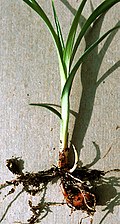Cyperus esculentus
Cyperus esculentus, also known as tiger nut, yellow nutsedge or earth almond, is a species of sedge native to warm temperate to subtropical regions of the Northern Hemisphere. It is considered a weed in some regions, but also has a long history of use for its edible tubers.
Description[edit]
Cyperus esculentus is a perennial plant that grows up to 90 cm tall. The leaves are linear, 3-10 mm wide, and the flowers are produced on spikes at the top of the stems. The tubers are small, round, and brown, resembling a small nut. They have a sweet, nutty flavor and can be eaten raw or cooked.
Distribution and habitat[edit]
Cyperus esculentus is native to the Old World, but has been introduced and naturalized in many other parts of the world, including North and South America, Australia, and New Zealand. It grows in a variety of habitats, but prefers moist, sandy soils.
Uses[edit]
The tubers of Cyperus esculentus have been used as a food source for thousands of years. They were a staple food in ancient Egypt and are still consumed in many parts of Africa, the Middle East, and Southern Europe. The tubers can be eaten raw, roasted, or ground into a flour. They are also used to make a sweet, milky drink called horchata in Spain.
In addition to their culinary uses, the tubers are also used in traditional medicine. They are believed to have diuretic, stimulant, and aphrodisiac properties.
Cultivation[edit]
Cyperus esculentus is easy to grow and can be cultivated in a variety of soil types. It prefers full sun and regular watering. The tubers can be harvested in the autumn, after the tops of the plants have died back.
See also[edit]
References[edit]
<references />
Cyperus esculentus[edit]
-
Cyperus esculentus L. on white background
-
Chufa
-
Procés de cultiu de la xufa
-
Cyperus esculentus NRCS
-
Horchata Chufas from Alboraya for sale in Valencia, Spain
-
Cyperus esculentus MS 4388
Ad. Transform your life with W8MD's Budget GLP-1 injections from $75


W8MD offers a medical weight loss program to lose weight in Philadelphia. Our physician-supervised medical weight loss provides:
- Weight loss injections in NYC (generic and brand names):
- Zepbound / Mounjaro, Wegovy / Ozempic, Saxenda
- Most insurances accepted or discounted self-pay rates. We will obtain insurance prior authorizations if needed.
- Generic GLP1 weight loss injections from $75 for the starting dose.
- Also offer prescription weight loss medications including Phentermine, Qsymia, Diethylpropion, Contrave etc.
NYC weight loss doctor appointmentsNYC weight loss doctor appointments
Start your NYC weight loss journey today at our NYC medical weight loss and Philadelphia medical weight loss clinics.
- Call 718-946-5500 to lose weight in NYC or for medical weight loss in Philadelphia 215-676-2334.
- Tags:NYC medical weight loss, Philadelphia lose weight Zepbound NYC, Budget GLP1 weight loss injections, Wegovy Philadelphia, Wegovy NYC, Philadelphia medical weight loss, Brookly weight loss and Wegovy NYC
|
WikiMD's Wellness Encyclopedia |
| Let Food Be Thy Medicine Medicine Thy Food - Hippocrates |
Medical Disclaimer: WikiMD is not a substitute for professional medical advice. The information on WikiMD is provided as an information resource only, may be incorrect, outdated or misleading, and is not to be used or relied on for any diagnostic or treatment purposes. Please consult your health care provider before making any healthcare decisions or for guidance about a specific medical condition. WikiMD expressly disclaims responsibility, and shall have no liability, for any damages, loss, injury, or liability whatsoever suffered as a result of your reliance on the information contained in this site. By visiting this site you agree to the foregoing terms and conditions, which may from time to time be changed or supplemented by WikiMD. If you do not agree to the foregoing terms and conditions, you should not enter or use this site. See full disclaimer.
Credits:Most images are courtesy of Wikimedia commons, and templates, categories Wikipedia, licensed under CC BY SA or similar.
Translate this page: - East Asian
中文,
日本,
한국어,
South Asian
हिन्दी,
தமிழ்,
తెలుగు,
Urdu,
ಕನ್ನಡ,
Southeast Asian
Indonesian,
Vietnamese,
Thai,
မြန်မာဘာသာ,
বাংলা
European
español,
Deutsch,
français,
Greek,
português do Brasil,
polski,
română,
русский,
Nederlands,
norsk,
svenska,
suomi,
Italian
Middle Eastern & African
عربى,
Turkish,
Persian,
Hebrew,
Afrikaans,
isiZulu,
Kiswahili,
Other
Bulgarian,
Hungarian,
Czech,
Swedish,
മലയാളം,
मराठी,
ਪੰਜਾਬੀ,
ગુજરાતી,
Portuguese,
Ukrainian






